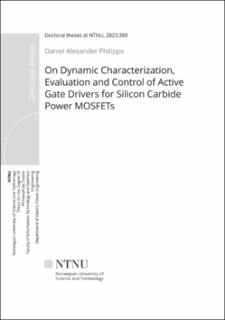| dc.contributor.advisor | Peftitsis, Dimosthenis | |
| dc.contributor.advisor | Nilsen, Roy | |
| dc.contributor.author | Philipps, Daniel Alexander | |
| dc.date.accessioned | 2023-11-15T08:34:49Z | |
| dc.date.available | 2023-11-15T08:34:49Z | |
| dc.date.issued | 2023 | |
| dc.identifier.isbn | 978-82-326-7475-6 | |
| dc.identifier.issn | 2703-8084 | |
| dc.identifier.uri | https://hdl.handle.net/11250/3102619 | |
| dc.description.abstract | Silicon Carbide (SiC) powerMetal-Oxide-Semiconductor Field-Effect Transistors (MOSFETs) bear the potential of revolutionizing power electronic converters in regard to high efficiency, but also high power density converters and converter in harsh environmental conditions. These devices switch at unprecedented speed that can easily cause interference and risk to the surrounding circuitry.
Power MOSFETs require gate driver circuits to be switched on or off. Conventionally, Two Level Voltage Source Gate Drivers (VSGDs) have been used to realize this functionality. However, both the static and dynamic behavior of SiC powerMOSFETs strongly depends on the operating conditions, such as DC voltage and load current. Two Level VSGDs cannot account for these changes, which results in suboptimal utilization of the powerMOSFETs in a wide range of operating conditions.
Active Gate Drivers (AGDs), as opposed to conventional Two Level VSGDs, can be adjusted during the run time of the converter and therefore adapt the powerMOSFET behavior to changing operating conditions. AGDs will therefore be of major importance to optimally utilize the advantages of SiC power MOSFETs in future power converters.
This work presents contributions concerning the accurate dynamic SiC powerMOSFET characterization, AGD design and evaluation methodologies by means of two concrete examples, as well as control signal delivery to AGDs.
The outcomes in these three subtopics are:
• A Low-Inductive Test Platform for accurate dynamic characterization of SiC powerMOSFETs driven by conventional or active gate drivers,
• TwoMultilevel Voltage Source Gate Drivers (MLVSGDs) offering switching slope and loss control as well as synchronous rectifier overshootvoltage suppression, and
• A systematic method ofWireless Communication Technology (WCT) adaptation in Power Electronics Systems (PES) demonstrated by the example of Bluetooth Low Energy (BLE) for wireless control of an MLVSGD. | en_US |
| dc.language.iso | eng | en_US |
| dc.publisher | NTNU | en_US |
| dc.relation.ispartofseries | Doctoral theses at NTNU;2023:388 | |
| dc.relation.haspart | Philipps,Daniel Alexander; Peftitsis, Dimosthenis.
Performance Evaluation of High-Power, High- Bandwidth Current Measurement Technologies for SiC Switching Devices | en_US |
| dc.relation.haspart | Philipps, Daniel Alexander; Xue, Peng; Ubostad, Tobias Nieckula; Iannuzzo, Francesco; Peftitsis, Dimosthenis. Low Inductive Characterization of Fast-Switching SiC MOSFETs and Active Gate Driver Units. IEEE transactions on industry applications 2023 ;Volum 59.(5) s. 6384-6398 https://doi.org/10.1109/TIA.2023.3282930 | en_US |
| dc.relation.haspart | Ekren, Halvor Bratvold; Philipps, Daniel Alexander; Rødal, Gard Lyng; Peftitsis, Dimosthenis. Four Level Voltage Active Gate Driver for Loss and Slope Control in SiC MOSFETs. IEEE International Symposium on Power Electronics for Distributed Generation Systems (PEDG) 2022 https://doi.org/10.1109/PEDG54999.2022.9923113 | en_US |
| dc.relation.haspart | Giannakis, Andreas; Philipps, Daniel Alexander;
Blinov,Andrei; Peftitsis, Dimosthenis.
A Three-Level Voltage-Source Gate Driver for SiC MOSFETs in Rectification Mode - CPE Powereng Conference Proceedings | en_US |
| dc.relation.haspart | Philipps, Daniel Alexander; Peftitsis, Dimosthenis.
Wireless Control of Active Gate Drivers for Silicon Carbide power MOSFETs. IEEE Open Journal of the Industrial Electronics Society (OJ-IES) 2023 https://doi.org/10.1109/OJIES.2023.3326380 - CC BY | en_US |
| dc.title | On Dynamic Characterization Evaluation and Control of Active Gate Drivers for SiC power MOSFETs | en_US |
| dc.type | Doctoral thesis | en_US |
| dc.subject.nsi | VDP::Technology: 500::Electrotechnical disciplines: 540 | en_US |
| dc.description.localcode | “In reference to IEEE copyrighted material which is used with permission in this thesis, the IEEE does not endorse any of NTNU’s products or services. Internal or personal use of this material is permitted. If interested in reprinting/republishing IEEE copyrighted material for advertising or promotional purposes or for creating new collective works for resale or redistribution, please go to http://www.ieee.org/publications_standards/publications/rights/rights_link.html to learn how to obtain a License from RightsLink. | en_US |
